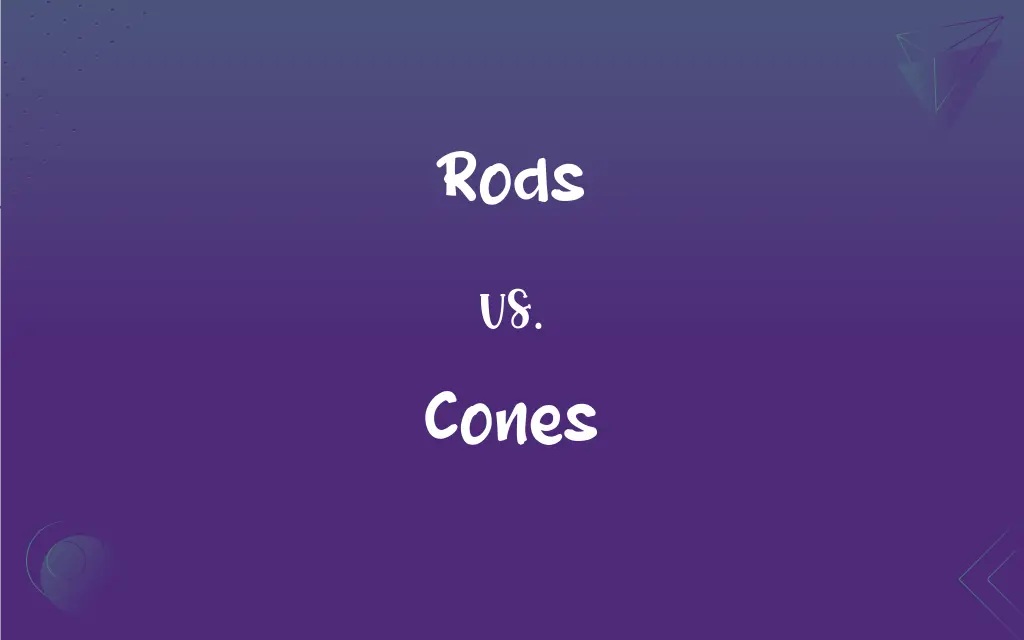Rods vs. Cones: What's the Difference?
Edited by Aimie Carlson || By Harlon Moss || Updated on October 6, 2023
Rods detect low light and black and white vision; Cones discern color and handle daylight vision.

Key Differences
Rods and Cones are specialized cells found in the retina of our eyes, playing crucial roles in vision. Rods predominantly help in low-light conditions, allowing us to see even when it's relatively dark. Their function is integral to our night vision. While they don't facilitate color vision, Rods are highly sensitive to light, making them vital for detecting shades of gray.
Cones, conversely, are pivotal for our daytime vision. They provide the sharpness and clarity we experience in well-lit conditions. Unlike Rods, Cones enable us to perceive colors. There are three types of Cones in our eyes, each sensitive to a particular wavelength of light corresponding to blue, green, or red hues.
The distribution of Rods and Cones is not even across the retina. The central part of the retina, called the fovea, is densely packed with Cones, explaining why it's the point of sharpest vision. Conversely, Rods are more numerous and are spread throughout the periphery of the retina.
Rods and Cones transduce light into neural signals. These signals are then processed and sent to the brain through the optic nerve. While both are crucial for vision, the differentiation in their functions — with Rods managing low-light and grayscale and Cones handling color and detail — underlines their distinct contributions to our visual experience.
Comparison Chart
Function
Detect low light, black and white vision
Discern color, manage daylight vision
ADVERTISEMENT
Light Sensitivity
High
Low (require more light)
Distribution
Mostly in the periphery of the retina
Concentrated in the fovea
Types
One type
Three types (blue, green, red sensitive)
Day/Night Vision
Night vision
Daytime, color vision
Rods and Cones Definitions
Rods
Cells in the eyes assisting with night vision.
Rods become more active as the sun sets, aiding dusk and nighttime sight.
ADVERTISEMENT
Cones
Cells in the eyes that function optimally in daylight.
Cones allow us to enjoy a sunny day at the beach with clarity.
Rods
Photoreceptor cells in the retina sensitive to low light.
Thanks to Rods, we can navigate in dimly lit environments.
Cones
Photoreceptor cells in the retina responsible for color vision.
The vibrant hues of a rainbow are detected by our Cones.
Rods
Retinal cells that perceive grayscale.
The movie, in its lack of color, relied heavily on our Rods for visual comprehension.
Cones
Retinal cells with three variations, each sensitive to certain light wavelengths.
The diversity in Cones helps us distinguish between a myriad of colors.
Rods
Light-sensitive cells predominantly outside the fovea.
The peripheral vision heavily uses Rods, especially in darker surroundings.
Cones
Cells designed for detailed and color-rich visual experiences.
Admiring an artwork, our Cones help us appreciate its intricate details and colors.
Rods
Cells less suited for detail but highly efficient in dim light.
While stargazing, our Rods help us detect the faint glow of distant stars.
Cones
Light-sensitive cells concentrated in the fovea.
Reading a book relies on the Cones in the fovea for sharp, detailed vision.
Rods
A fishing rod.
Cones
The surface generated by a straight line, the generator, passing through a fixed point, the vertex, and moving along a fixed curve, the directrix.
Rods
A piston rod.
Cones
A right circular cone.
Rods
An often expandable horizontal bar, especially of metal, used to suspend household items such as curtains or towels.
Cones
The figure formed by a cone, bound or regarded as bound by its vertex and a plane section taken anywhere above or below the vertex.
FAQs
Do Rods and Cones work simultaneously?
Both can function at the same time, but specific conditions may favor one over the other.
How do Cones contribute to our vision?
Cones enable us to perceive colors and function best in daylight.
What primary function do Rods serve?
Rods are essential for low-light and black and white vision.
Why can't we see colors well at night?
Night vision relies on Rods, which detect grayscale and not color, unlike Cones.
How do Rods react to a sudden darkness after bright light?
Rods take time to adapt, which is why our eyes need adjustment time in sudden darkness.
Is the distribution of Rods and Cones the same in every person?
While there's a general pattern, individual variations exist in the distribution and density of Rods and Cones.
Can age affect the functionality of Rods and Cones?
Yes, age-related changes can affect the number and functionality of both Rods and Cones.
Can artificial lights impact the functioning of Rods?
Bright artificial lights can reduce Rods' activity, similar to how they operate during daylight.
What happens to Cones in very dim light?
Cones are less active in dim light, making color vision poor.
Which cells help us see stars at night?
Rods, being sensitive to low light, assist in seeing stars.
Why do colors look faded at dusk?
As light diminishes, Cones become less active, and Rods take over, making colors less vibrant.
How do sunglasses impact Cones?
Sunglasses reduce light intensity, but Cones still function, ensuring color perception.
Are there more Rods or Cones in our eyes?
There are more Rods in the human retina than Cones.
Why is the center of our vision so sharp and colorful?
The fovea, dense with Cones, handles detailed and color-rich vision.
Are animals' eyes similar in terms of Rods and Cones?
Different species have varying distributions of Rods and Cones, affecting their visual abilities.
Do both Rods and Cones send signals to the brain?
Yes, both transduce light into neural signals sent to the brain via the optic nerve.
Are there diseases that specifically affect Rods?
Yes, conditions like retinitis pigmentosa primarily impact Rods, leading to night blindness.
How vital are Cones for reading and close-up work?
Extremely, as Cones provide the detailed and color vision necessary for such tasks.
Can someone be deficient in Cones?
Yes, color blindness often results from a deficiency or malfunction of certain Cones.
Why do artists need to understand Cones' functionality?
Knowing about Cones aids artists in understanding color perception and visual clarity.
About Author
Written by
Harlon MossHarlon is a seasoned quality moderator and accomplished content writer for Difference Wiki. An alumnus of the prestigious University of California, he earned his degree in Computer Science. Leveraging his academic background, Harlon brings a meticulous and informed perspective to his work, ensuring content accuracy and excellence.
Edited by
Aimie CarlsonAimie Carlson, holding a master's degree in English literature, is a fervent English language enthusiast. She lends her writing talents to Difference Wiki, a prominent website that specializes in comparisons, offering readers insightful analyses that both captivate and inform.































































